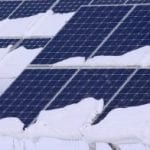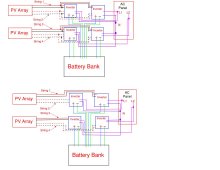ok good this is the kind of confirmation I have been looking for, if I only had 2 inverters I would have 2 strings on each inveter and when it is talked about stacking or paralleling a couple inverters, you can parallel the charging of the battery bank connections and of the ac output connections, but you don't parallel the PV array connection with another inverter.
Thank you very much for you input it has been very helpful. Perhaps one day I will be able to help you the same , if you ever need input regarding typical AC Voltage concerns hit me up , been an electrician for over 30 years
Yeah, the only charge controller paralleling that 'could' potentially exist (across the all-in-ones), is if whether the vendor might use paralleling-stacking communication to synchronize the battery charging stages across inverters. As far as I know, none of the consumer all-in-one inverter/ charge controllers support syncing charge stages across the multiple charge controllers.
I do run a pair of Victron charge controllers in conjunction with a BMV smart battery monitor, where I've enabled Victron's sync charging mode, where you create a network group (in my case via bluetooth connection), by adding all the chargers into the group (in the VictronConnect app), along with the BMV battery monitor (single point to read battery voltage, current, and temperature), and it delegates one of the chargers to be a master, and other ones are slaves, then all the chargers will stay on the same battery charge cycle together. This helps to optimize the max watts charging potential, so one charger doesn't go into float too soon (as they are all reading slightly different voltages), while others might still be in absorption stage or something.
It's not a huge requirement (can also manually tweak and calibrate the chargers' charge stage voltages (in small increments) to get the stages matched pretty close) but I would expect to see more manufacturers implementing this type of functionality into the parallel stackable all-in-ones at some point in the future, but for now, I don't believe any of them have this now. I think only Victron has done this (as far as consumer-grade solar equipment), but not totally sure...
Any function like this though, would be completely independent of what the inverter portion of the all-in-one is doing in regards to the AC output parallel operation.





